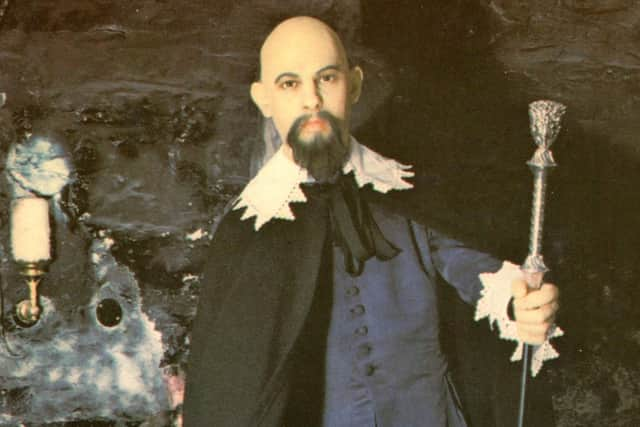From Madame Tussaud to chambers of horrors, waxworks and Edinburgh share a long and dark association


The first person to show waxworks models to the people of Edinburgh was none less than Madame Marie Tussaud herself, who opened an exhibition at Bernard’s Rooms, 28 Thistle Street, in June 1803. The models were mostly of French personages: the First Consul and Madame Bonaparte, the unfortunate late King and Queen, various nobles who had also perished on the guillotine and the Count de Lorge who had been in the Bastille for 20 years.
Tussaud liked Edinburgh very much, and the profits from her show were excellent, she would be back in Edinburgh in 1810, exhibiting at the Panorama in Leith Walk, and various travelling showmen would grace the Athens of the North with their waxen effigies in the years to come, but it would take until 1863 for the city to get its first permanent waxworks museum.
Advertisement
Hide AdAdvertisement
Hide AdThat year, the Grand Historical Galleries of Waxworks and Museum opened at 11 South Bridge, taking over the premises of Anderson’s Temperance Hotel. It would remain active for many years, attracting regular patrons. As the years went by, the museum grew steadily, and by the 1890s all the rooms of the former hotel were full to capacity.


The Criminal Department contained a group of Burke and Hare, Helen M’Dougall, Daft Jamie and Helen Paterson. The murderers Dr Pritchard, Eugène Chantrelle, Percy Lefroy Mapleton, Jessie King, Kate Webster and Mrs Pearcey were also present.
The antiquities on show included the bolt and hinges of the Glasgow gallows, some curious prints of Edinburgh’s most infamous serial killers Burke and Hare, a painting of the old Edinburgh worthy Cocoanut Tam and a carved model of Salisbury Cathedral that had taken 35 years to manufacture.
A catalogue of the South Bridge waxworks was issued in the 1890s, the museum was owned by Matthew McLeod, who had managed the premises for many years. In the 1910s, the old waxworks museum fell upon evil times, and in March 1913, McLeod decided to sell it. But although the museum was said to boast a 'most magnificent collection, with original and valuable costumes, and antiquities of great historical interest', there were no takers, and the entire collection was put up for auction in May 1914.In September 1895, Edinburgh would get its second waxworks museum when Stewart’s Waxworks opened its gates at 164-166 High Street, where it occupied the ground and first floors, as well as the basement.
From the beginning, it was a vigorous, earthy and downmarket establishment, catering mainly to the lower classes of society. It cost tuppence to enter, with an extra charge of one penny to view a slightly titillating moving picture like Bathing Belles of Brighton, and another penny to descend to the basement for the Chamber of Horrors, which was filled to capacity with models of celebrated criminals. The first scene up the stairs was Catherine Douglas barring with her arm a door at Blackfriars Monastery, Perth, in a vain attempt to keep out the murderers of James I.


The manager, Frederick Stewart, had started his career in Dundee in 1893, briefly surfacing at the Trongate in Glasgow the year after. At the time he moved to Edinburgh, he had another waxworks museum at 108 Upper Street, Islington, where the wax models were made by the artist Albert De Witt.
He was a clever and enterprising man who realised that waxworks had their limitations when it came to attracting the paying customers. His solution was to open a freak show at the Waxworks, and to make sure that there was always some curiosity on show. Already in February 1896, the conjurer Carl Vane and Madame Ella the Tattooed and Clairvoyant Lady were at large at the premises.
Sometimes, the show contained four-legged, feathered or reptilian performers: Don Duval’s Dog and Bird Circus featuring the Boxing Cockatoo, Signor Valerio the King of the Feathered Tribe, the snake-charmer Arizona Bill the Monster King, and Captain Medecia’s singing, talking and musical sea lions.
Advertisement
Hide AdAdvertisement
Hide AdAt other times, conventional human 'freaks' were resident on the premises: Miss Campbell, the Scottish Giantess; Miss Frances Sinclair, Her Majesty’s Heaviest Living Subject, weighing in at 40 stone; or the Armless Lady who writes, works a sewing machine and plays the piano with her feet and toes.


Unzie the albino, Madame Zelda the escape artist, Admiral Mite the midget and Leonine the Lion-faced Woman also all came and went.
Conjoined twins, a half-man-half-elephant and a giant schoolboy, early waxworks brought freak shows to Royal Mile
Jan Bondeson is the author of Murder Houses of Edinburgh, published by Troubador, available from www.troubador.co.uk
A message from the Editor:


Thank you for reading this article. We're more reliant on your support than ever as the shift in consumer habits brought about by coronavirus impacts our advertisers.
If you haven't already, please consider supporting our trusted, fact-checked journalism by taking out a digital subscription
Comments
Want to join the conversation? Please or to comment on this article.